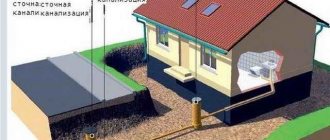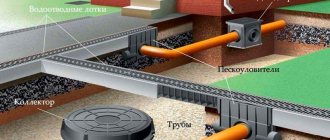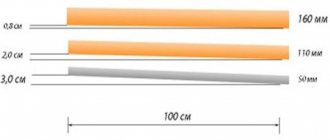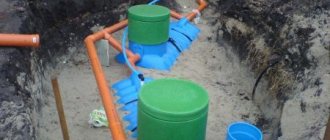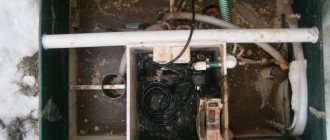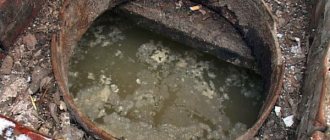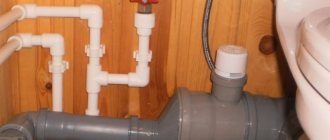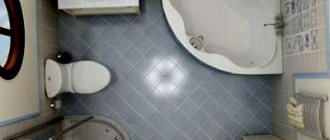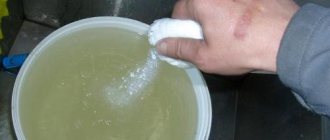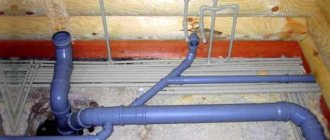Living without amenities today suits few people, especially since sewerage in a private house is a troublesome matter, but many actions can be done with your own hands, the main thing is to prepare responsibly - there are many photos and videos on this topic on the Internet.
In private homes, sewer and water supply systems usually remain in the shadows, both literally and figuratively, which is why their organization often raises a number of questions for homeowners. The main difficulty of designing a sanitary system is that it is precisely regulated by regulations, but the ability to navigate them can help you choose the right designer, and perhaps even draw up a communications diagram yourself. In addition, there are a number of nuances and practical recommendations for sewerage equipment, which are also worth familiarizing yourself with in advance.
Choosing a location for a septic tank
The optimal location of the septic tank is selected in advance, taking into account the dimensions of the product and the parameters of the site.
There are several factors that influence the location of the septic tank:
- terrain slope;
- depth of groundwater;
- the distance to which the soil freezes in winter;
- the presence of a nearby source of water or running water;
- soil composition.
When installing a septic tank, pay attention to the distance from the house; it must be at least 5 m. There should not be a well or well next to the collector; they must be at least 30 m away.
Trees and other plantings are 3 m away. The location for the tank is chosen so that a sewage truck can drive up to it.
Specifics of installation work
Is it possible to make an autonomous sewer system yourself? This is the first question that arises for most users after reading the prices for ready-made models. Assembling an autonomous system is quite possible, however, it is necessary to first study the rules and specifics of installation.
First of all, you need to draw up a project. It must contain an autonomous sewerage diagram drawn up in accordance with all the rules. There is a system of tolerances that limits the distance between the elements of the system and objects located on the site. The most stringent requirements for tank location:
- to the house - at least 5 m;
- to the drinking well - 25 m;
- drinking well - 50 m;
- to a river or stream - 10 m;
- to a lake or reservoir - 30 m;
- site boundaries (fence) - 5 m;
- to fruit trees - 3 m.
In practice, it can be difficult to maintain all distances. As a rule, first of all they try to ensure standard distances to the house or neighbors’ buildings so that no conflicts arise. Bad odors and the risk of contamination of soil or drinking aquifers become serious problems, often causing controversy or even litigation. Therefore, violation of permissible distances may become an argument in favor of dismantling the system.
The construction process occurs in stages:
- site marking;
- excavation. They make recesses for wells and tanks, a trench for laying pipes;
- install the container. The foundation is poured, or a concrete slab is laid for the base. The walls of the tank are sealed and insulated;
- pipes are laid. it is necessary to ensure a given slope, install a heat insulator and a heating cable;
- check the performance of the system. drain the water and inspect the connections. If no defects are found, the trench sinuses are filled up and operation of the system begins.
Excavation work can be done manually or using construction equipment. It is necessary to provide a passage for the cesspool machine so that you do not have to clean the container manually afterwards.
Types of autonomous sewerage
In order to consciously and correctly choose the type of sewage system for your dacha, you need to at least in general terms imagine the advantages and disadvantages of each of the possible options. There are not so many of them:
- Cesspool. The most primitive and far from the best way to dispose of wastewater. Let's start with the fact that it is very difficult to ensure complete tightness. Even with high-quality treatment, some part of the wastewater ends up in the ground. If the source of water is a well or borehole, then sooner or later bacteria will be found in them that live in sewage pits. Other disadvantages are the corresponding smell, which is problematic to combat due to leaks, and the need for regular pumping. Therefore, such sewage systems are being built less and less often in the country.
- Storage capacity. The essence of this type of sewage system is the same: wastewater is collected in containers and periodically pumped out. Only these containers are completely sealed, as they are usually made of plastic. The disadvantage is the relatively high price.
- Septic tanks. A system of several interconnected containers (two - three, rarely more). Wastewater enters the first, where it settles and is processed by bacteria. Insoluble residues settle to the bottom, water rises to the top. The next time wastewater arrives, the level rises and the settled water is poured into the next container. Other bacteria “live” here and complete the cleaning (up to 98%). From the second compartment of the septic tank, the liquid can be removed for further filtration into the ground. It's almost clean now. The design is simple, there is nothing to break. The disadvantage is that the device itself is bulky, plus it requires a filtration field (where the water will be discharged), once a year or two the septic tank is cleaned of insoluble sediment.
- VOC or AC - local treatment stations or automatic installations. The principle of operation of a septic tank, but in a more compact size, with electronic filling for control. This type of sewer only works when there is electricity. The maximum battery life is up to 4 hours. The small size of VOCs impose restrictions on one-time discharge of wastewater: if you flush the bathtub, you should not flush the toilet. And the main disadvantage is the price.
The first two options are simply places for collecting waste; no purification occurs in them. But there is a difference between them, and quite significant. A cesspool is usually made only for an outdoor toilet, but all wastewater is already diverted into a storage tank. That is, this is the most primitive sewage system, albeit without cleaning.
The second two options are already treatment facilities, just with different degrees of automation. As you can see, there is no ideal way. You have to choose between environmental friendliness and cheapness. And here no one can decide except you.
Construction of an aeration field for autonomous sewerage
The final stage of work is the construction of an aeration field. This structure is a large filter made of crushed stone. At the selected site, where there are no plants or buildings, gravel is poured into a depression in the ground. It is not laid on open soil, but on geotextiles.
On top of the crushed stone you need to lay a perforated pipe connected to the last well of the autonomous sewage system. The pipeline is closed from above with an intrafilter. When the system is assembled, it must be covered with earth.
Sewage system made of concrete rings
A septic tank is made from concrete rings if the finished plastic tank does not fit in size. It will be easier to do construction work together, so it’s worth calling an assistant.
Advantages and disadvantages of the system
The advantages of the system include the fact that concrete rings are cheap and can be purchased by the general population. During construction, no drawing is required; you do not have to contact a specialized company.
But there are also disadvantages. For example, no matter how hard you try, you won’t be able to make the septic tank airtight, so unpleasant odors will be felt near it. You will also have to periodically hire vacuum cleaners to pump out the accumulated waste.
Scheme and calculations
An example of a septic tank layout at a summer cottage.
A septic tank is made of several rings, they are installed on top of each other. The treatment scheme may include 1 or 2 chambers. For a summer residence, you can choose a simple option from a sump, which is supplemented with a well for filtration.
When performing calculations, SNiP is taken into account. Based on the number of people living in the house, determine the required volume of the sump. It should be able to accommodate waste waste for 3 days.
Preparatory processes
Before installing concrete rings, a pit is dug. A septic tank and a well for filtration must fit freely into it. Sand is poured into the bottom of the hole and compacted. The result should be a pillow with a thickness of 30 to 50 cm.
The bottom of the pit is concreted. If this is not possible, you can purchase 1 concrete ring with a solid bottom. During installation, it is placed first on a sand bed.
Installation of rings
To install reinforced concrete rings you will need special equipment. They are fixed together with staples; instead of them, metal plates can also be used. Additionally, all parts are fastened together with concrete mortar.
After installation is completed, an overflow is made, and sewer pipes are connected to the concrete rings.
Sealing
To make reliable waterproofing, the solution must have a water barrier. The outside of the collector is covered with coating materials, but they can be replaced with built-up materials.
Plastic cylinders can be placed inside the concrete rings. This will reduce the likelihood of leakage to a minimum.
Installation of septic tank rings using special equipment.
Installation of floors and backfilling
The reinforced concrete rings are covered on top with a concrete slab in which a hole is made for a sewer hatch. Fill the septic tank with soil mixed with sand. When the work is completed, the sewer can be put into operation.
Construction of a local drainage system
In private houses there is a close connection between the sewer and water supply systems. After all, the entire volume of water that is used by the residents of the house and waste must be disposed of somehow. Modern theory and practice of autonomous sewage systems are described in many scientific works, but theorists often omit the most important aspect - the cost of implementing their idea.
For example, a project from a technical point of view is impeccable, but implementation will require huge financial costs, which does not bother the sewer system theorist at all. But for real owners, the price of an autonomous sewer system is crucial, so every owner of a private house should be able to and know how to install a sewer system in a house.
Sewage device
Before making a sewer system with your own hands, you need to take into account all the sanitary and technological requirements and estimate the layout of the main pipes and the final cleaning device.
The decisive factors for arranging waste disposal are:
- Location of the house on the site.
- Relief of the yard, soil indicators.
- The wishes of the owner of the site and the requirements of the authorities for the quality of waste treatment.
- Availability of a certain list of plumbing fixtures.
Sometimes, if the dacha is located in a protected water area, then the requirements for wastewater treatment are increased and the construction of a simple cesspool is not permitted by law.
A good solution is when the drain from all plumbing fixtures is directed through one common pipe to a selected location, where the sewage is simply collected for further removal or subject to cleaning.
Sometimes excrement comes through different pipes from several buildings that lead to one septic tank. Maintenance of this sewer option can be complicated due to turns and a large number of connections.
Internal sewerage distribution. The internal sewer network is made of cast iron or plastic pipes with a diameter of 50 mm; a slope of at least 2 cm per linear meter is provided. Output to the outside is carried out through the wall of the dacha or a hole is punched in the foundation.
If, during the construction of a house, the place where the sewer pipe will exit through the foundation is calculated in advance, then in order not to break the concrete later, one or two empty glass bottles with a volume of 3 liters are laid horizontally in the place where the pipes pass and filled with concrete. If it is necessary to lay pipes, this place is knocked out with a crowbar.
Design stage
When a country house is being built, it is most often done according to an individual project. Accordingly, there is no standard sewerage design for it, and you will have to do the calculations yourself. To do this, you need to know the basic rules for designing sewer systems and their structure. First, they draw a diagram of the internal sewerage system indicating all the plumbing fixtures and the parameters of the pipes between them.
For external sewerage, the main parameter is the performance of septic tanks, which depends on the number of people living in the house and the number of plumbing fixtures. In addition, the depth of laying the pipeline and septic tanks into the ground or the degree of their insulation in the case of outdoor installation is of no small importance. These parameters depend on climatic conditions. The main condition here is to maintain a temperature in the septic tank sufficient for the life of bacteria that decompose sewage. The optimal temperature is 50 degrees. The selected type of septic tank depends on the geological structure of the soil layers and the depth of groundwater in the area.
Anyone who is going to design an autonomous sewer system in a country house must understand that it consists of several interconnected parts:
- The internal sewerage system consists of a certain number of pipes, which are interconnected into a common network through shaped connecting parts. It has a common outlet from the house and is connected to the external sewerage system through a so-called non-return valve, which is designed to prevent water from rising into the house when the containers outside are overfilled. Internal sewer networks are sometimes present not only in the house itself, but also in other buildings located on the site. In this case, each of them has its own outlet connected to the septic tank.
- There are several types of external sewerage system: cesspool (suitable for rarely visited places, such as a cottage or bathhouse), storage tank (suitable for small amounts of water), septic tank or biological treatment station (the most suitable options for a full-fledged country house with permanent residence) .
- A storm sewer system is installed on poorly drained soils around the house. It can be independent, but sometimes it is integrated into the overall system.
For proper installation, any of these systems must be carefully calculated.
Where does the construction of a sewer system begin?
First of all, you need to choose one of 3 types of sewerage:
- Cesspool.
- Storage containers.
- Septic tanks.
cesspool
This type is an outdated form of sewage collection. Today it is considered not only ineffective, but also dangerous to humans and the environment. It is not for nothing that specialized SNiPs state that cesspools can only be used in those houses that emit no more than 1 cubic meter of sewage and sewage. Therefore, this type of sewage system is extremely rare today.
Storage containers
Storage tanks are a common method of arranging sewage systems in suburban areas. They can be of any shape, any type of installation (vertical or horizontal) and are made of various materials.
Reinforced concrete rings have become the most popular among country developers. Installing a sewer system in a dacha with their help is quite simple. The only inconvenience is the need to use special equipment. The rings are quite heavy, so they cannot be handled manually.
There are other options for storage tanks. For example, metal, plastic, as well as wells made of bricks or blocks. So each developer can choose the appropriate option for himself.
The only condition that requires strict fulfillment is the complete tightness of the container. Not a single crack, not a single crack - absolute sealing. In this way, the soil is protected from contamination by human waste.
But this option has a drawback - such a container will have to be cleaned as it fills. There are several cleaning methods:
- Sewage machine. This is a fast and effective option, but very expensive.
- Bleeding pump. This is also a good method, but the wastewater will have to be poured into a separate container and transported outside the countryside to a public disposal site.
- Manual. The entire tool is a rope and a bucket. The method is unpleasant, difficult and dirty. I don't even want to talk about him.
Septic tanks
Installation of a septic tank at the dacha
But a septic tank is perhaps the best option today. It is not just a storage tank, but a system for sequential wastewater treatment.
Its structure is not as complicated as it might seem at first glance. The principle of operation is important here, which is divided into two main stages - pre-cleaning and filtration.
The first stage takes place in a sealed container, where the wastewater is separated into heavy and light. The heavy ones sink to the bottom, and the light ones with water enter the filtration tank or filtration fields.
Today, septic tanks of different shapes, sizes and materials are used, but the principle of their operation is the same. Most often they are made from reinforced concrete rings or ready-made plastic models are used. Sometimes they choose options built from bricks or blocks.
Reinforced concrete septic tanks consist of 2 or more wells, where wastewater flows sequentially. The first well plays the role of a storage tank, and the second - a filtering tank. Through its bottom, purified water enters the soil, and, having passed through all its layers, enters the groundwater
Please note that the more storage wells, the cleaner the output water
Ready-made plastic containers are more effective in this regard. Their internal space is divided into several compartments, from which waste flows in a sequential order. And the more compartments, the cleaner the water.
How to choose an autonomous sewer system for a private house
In private houses, in the absence of a centralized sewerage system, the solution is to arrange an autonomous drainage system. There are various types of septic tanks on the market; they differ in operating principle, price and durability.
The selection of a septic tank must begin with the definition:
- The purpose of the house is for permanent or temporary residence. There are models of cleaning equipment for which prolonged downtime is contraindicated. For dachas, a cesspool would be better suited.
- Area of the site, soil composition and water course. It is not possible to install a filtration field in small areas. If aquifers lie close to the surface, a filtration well will not be suitable.
- Number of discharges per day - this indicator is calculated depending on the number of people living in the house. It is stated in the instructions for the device.
The productivity of the equipment should be equal to three times the size of wastewater per day, since the cleaning process takes 3 days. According to standard standards, there are 200 liters of drainage per person. If three people live in a house, then the storage capacity is:
200 l x 3 people x 3 days = 1800 l or 1.8 m³
- Depths of drainage pipes. For most models, the pipes cut 800 mm below the ground surface. And since the installation is carried out with a slope, the fan pipe must be no lower than 700 mm.
- System material. The installation process, operation and maintenance of an autonomous sewer system depend on its properties and quality.
- Your financial capabilities. Buying high-tech models and maintaining them will be expensive. You can reduce costs by installing one or two-chamber septic tanks.
If you are not sure about the correct choice of model, then contact knowledgeable people. The main thing to remember is that the equipment should last for more than one year.
Preparatory work
The sewer system is a complex mechanism that consists of separate parts:
- Internal sewerage is represented by a system of pipes inside the building. Its function: to remove waste water from plumbing fixtures to the external sewer system.
- External sewerage is a system of pipes that drain dirty water away from the building.
- A treatment or storage facility where wastewater is treated or stored for subsequent removal.
Sewage installation begins with the development of a detailed diagram. It will help you figure out what materials to buy and how much work needs to be done.
The sewerage diagram at the dacha reflects:
- Domestic wastewater sources. This includes a bath, shower, sauna, and sink.
- Method of connecting and laying pipes inside a building: hidden in the wall or under the cladding, brought out.
- The place in the house where the sewage system is discharged to the street;
- The trajectory of the external sewerage system;
- Place of installation of the sewer. The minimum distance from the house is 5 meters, from a source of natural water supply – 30 m, from trees and bushes – 3 m;
- Type of collector (biological treatment station, drainage pit, septic tank).
Sewage scheme at the dacha
When drawing up a diagram, you should take into account a number of factors that affect the type and design of the sewer system:
- depth of groundwater;
- the depth at which the ground freezes in winter;
- soil type and condition;
- landscape near the house;
- water supply on site.
Consult survey documents for soil information. If there are none, ask your neighbors or indigenous people.
The choice of collector depends on the data you receive and the type of soil. If sand predominates in it, then the ground easily allows runoff to pass through. Getting into groundwater, they pollute the environment. Therefore, it is better to use a collector with a bottom.
A cesspool without a bottom is not suitable for soil with a high concentration of clay. The rock does not conduct moisture well, which leads to rapid silting of the sewer.
Installation of sewer pipes is carried out below the freezing level of the soil. Otherwise, they will freeze and lead to breakdown of the drain system.
When developing a sewerage scheme, take into account that the water supply does not intersect with sewer pipes.
Industrial wastewater treatment plants
One solution to the problem of how to choose an autonomous sewage system in a country house may be the use of industrially produced sewage treatment systems. Modern purification systems are easy to operate and purify wastewater from coarse fractions, organic compounds and clarify purified water. The system is high-tech, so the price of an autonomous Topas sewer system for a dacha depends on the model and starts from 2,592 euros.
Another popular biological treatment system is Sani, which is available for different numbers of residents. For example, Sani-5 will provide sewerage for 5 people, and Sani-15 for 15 people. Sani's self-contained sewerage system consists of a primary and secondary settling tank.
Primary cleaning occurs under the action of microorganisms, as a result of which the unpleasant odor is eliminated.
For the Sani-5 model, the price of installing a sewer system in a private house will be about 1000 euros, not counting installation costs.
For installation in private homes and cottages, many owners prefer a cleaning system called “Tank”. It is easy to install without the involvement of third parties. The “Tank” is produced in five modifications with different volumes: from 600 liters to 1800 liters. Depending on the model, the price of an autonomous sewer Tank without installation costs is as follows:
- Tank-1 – from 302 euros.
- Tank-2 – from 445 euros.
- Tank-2.5 – from 500 euros.
- Tank-3 – from 608 euros.
- Tank 4 – from 780 euros.
In addition to the construction of treatment facilities for houses, cottages and summer cottages, storm water collection systems are created to drain rain and melt water. This system, known as the Los sewer, should not be confused with the wastewater sewer, because it has a completely different purpose. Storm drainage provides the following functions:
- drainage of excess rainwater from roofs, adjacent areas and paths of the site;
- protection of the foundation of the house and protection from moisture of rooms located below ground level;
- comprehensive protection of the site from waterlogging and erosion.
Septic tank installation
An example of a septic tank with biological treatment at a dacha.
There are septic tanks of different designs. Containers are made of plastic, reinforced concrete, brick, metal.
According to the method of waste treatment, all systems can be divided into the following:
- with biological treatment;
- requiring pumping with a sewer truck;
- Wastewater is filtered through the soil.
The last option is cheap, so it is widely used in dachas.
Two-chamber septic tank
A collector of 2 sections connected by an overflow pipe is considered the most convenient. It's easy to build with your own hands.
First, taking into account sanitary requirements, they select a place on the site, make a pit 3 m deep. A sand cushion is poured onto the bottom of the pit; its thickness should be at least 15 cm. After this, formwork is installed and reinforced with reinforcement. To do this, metal rods are used and they are tied together with wire.
The bottom of the first section is filled with concrete mortar; after it dries, a sealed compartment is obtained. Here the wastewater will be separated into fractions and settled. Large inclusions will settle to the bottom, and the clarified water will flow through the pipe into the adjacent section. In order for solid residues to decompose better, anaerobic bacteria populate the first compartment.
When building the second section, the bottom is not made, but a thick cushion of crushed stone and sand is poured. It will serve as a filter. The tank is constructed from reinforced concrete rings stacked on top of each other, or a monolithic structure is erected. The overflow pipe is installed between the 2 sections; it must be laid at an angle. Be sure to make a hatch and an exhaust hood, and cover the septic tank with a slab on top.
You can build not 2, but 4 reservoirs, then the water will be purified better. Such a septic tank will have to be cleaned once every 2 years.
Septic tank
A septic tank is a closed, autonomous system; when wastewater enters, it is purified by bacteria.
The main part of waste is water, and the function of autonomous sewage equipment is to purify it to a safe state. It is the septic tank that solves this problem; it separates the water from all the impurities that are located in it: chemical, biological and mechanical.
Liquid is separated from solid particles by pouring it from one compartment of the tank to another. This method of purification is of a low level, and additional purification with filters is necessary.
With filtration well
A septic device with a filtration well is sold ready-made, but they are easy to make with your own hands.
The structure is a container with compartments; passing through them, water is purified from solid components. It is important that the lower part of the filtration well is located above the aquifer of the soil. The bottom of the well has a two-layer cushion; it consists of coarse sand and crushed stone, and small or medium fractions.
The operating principle of this sewer:
- through pipes, discharges enter a sealed container;
- then solid particles settle at the bottom;
- and fats that are not subject to dissolution rise to the top.
Sometimes, such settling tanks have several compartments, and wastewater flows through them alternately. Then, the liquid waste purified in this way rises through the collector; it is usually placed in the wall of the tank at a height of 2/3 from the base, into a filtration well. They seep through the sand and crushed stone layer located at the bottom - this is how they are filtered.
To reduce the spread of odors coming from the storage tank, it is necessary to add compositions with anaerobic bacteria at certain intervals. Under the influence of these microorganisms, biowaste decomposes into safe elements.
During the operation of the well, the filtering crushed stone-sand layer becomes covered with silt, so it must be changed periodically. The rate of siltation of a well during its operation significantly depends on the composition of the soil.
In the presence of sand in the soil, the percentage of wastewater absorption is satisfactory, and the absorption of liquid by clay soil occurs slowly, and as a result it quickly becomes clogged. According to standards, the filter layer must be changed every 5 years, and waste pumping must be done once every six months.
Advantages of an autonomous sewer system with a well:
- Easy installation;
- Energy independence;
- Does not require maintenance - cleaning only once every 2 years.
Flaws:
- the device is not intended for areas with closely located groundwater;
- does not work with high clay content in the soil;
- the need to clean the well from silt deposits;
- low degree of filtration;
- the need to change the filter layer is a dirty and time-consuming procedure.
The construction is recommended for private houses with 2 - 3 residents. It is not intended for mass waste disposal.
Septic tank with filtration field
As requirements for environmental protection increase, autonomous cleaning devices will also improve. A septic tank with a filtration field is a multi-stage complex structure, with a sump, a well (distribution type), and an underground filtration field.
In addition, the device includes perforated pipes and a filter - a layer of sand and gravel.
The operating principle of this autonomous sewer cleaning system is simple. Sewage discharges are transferred to a settling tank with several chambers.
In the first, they settle and insoluble elements settle. In the next compartment, they are further, more efficiently cleaned. After the settling tank, the liquid enters the distribution well, from where it flows through the pipeline, and through the holes penetrates the soil and is absorbed by the field.
There are options that have an additional well behind the filtration field and a drainage device. Water from the drainage compartment is supplied to this well, from which it is pumped out by a pump.
The installation of such a sewer requires a large area, more than 30 m2. The degree of field productivity depends on the composition of the soil - in the presence of sand, better cleaning occurs, in clay there is low filtration.
When the system operates, filtered water accumulates in the aquifer or drainage device. The service life of a field until it is completely contaminated with silt is 10 years, then the layer of sand and gravel needs to be replaced.
The advantage of a drain with a filtration field is a high level of performance and no need for maintenance for a long time.
Disadvantages of such a structure: the need for large areas for arranging the filter, low degree of filtration, high costs during construction and cleaning.
The use of this type of autonomous sewer system is suitable for cottages where a large number of people live. You can lay out lawns on these fields, but planting fruit crops is prohibited.
Septic tank with infiltrator
An infiltrator is a substitute for a drainage pipeline. The structure occupies much less area than a filter field. The structure consists of a septic tank, pipes, crushed stone bed, infiltrator and fan.
The infiltrator is a pyramid-shaped box turned upside down. There is an entrance and exit in its walls, but there is no bottom. The device with a volume of 400 liters is equivalent to a 35-meter pipeline of the filtration field.
There are two types of septic tanks with an infiltrator; they differ in the presence of a well.
The operating principle of these types is as follows:
- Infiltrator without a well - discharges entering the septic tank pass through several settling tanks with certain purification methods. Then they flow through pipes into the infiltrator and are absorbed by crushed stone.
- Infiltrator with a well - waste after the septic tank enters the well compartment. There is a pump there; it pumps water into the infiltration tank, where it is absorbed into the crushed stone through a filtered bottom. This design is recommended for places with high groundwater levels.
Pros of the infiltrator:
- ease of installation;
- compactness;
- requires virtually no maintenance;
- withstands massive discharges.
Minuses:
- Needs cleaning - but rarely;
- The level of discharge treatment is not sufficient;
- A septic tank with a pump is dependent on electricity.
The use of an infiltrator with a well and a pump prevents the movement of waste back into the septic tank.
Installation of sewer system
Installation of sewer system
Now let’s answer the question of how to install a sewer system in a country house.
First of all, we will determine the location for the collection container.
And it doesn’t matter what it will be - a hole, a well or a plastic container. The optimal location is at the lowest point on the site
But keep in mind that if you chose the first two options and plan to clean the collection tank using a sewer truck, you will have to take care of the access road.
Once the location has been established, we begin excavation work. Sometimes their volume is so large that an excavator has to be used. If you decide to do everything manually, then it is better to dig a hole for the container and trenches at the same time.
The depth of laying sewer pipes should be 10-15 centimeters greater than the freezing level of the soil. This is the law.
True, in some northern regions this figure can reach more than 2.5 meters. In such cases, you have to use thermal insulation materials or install a heating cable so as not to dig deep.
The depth of the pit for the collection tank will depend on the depth of the sewer pipes. The fact is that the sewer pipes must have a slope from the house towards the tank. It is 2-3 centimeters per 1 meter of sewer network length. And the further the collection is from the house, the deeper it will have to be buried in the ground.
For country sewerage, the optimal material for pipes is polymer. And their diameter should be 110 millimeters. Such pipes are connected with couplings. But if there are side circuits, for example, sewage from a bathhouse or swimming pool, then the connection is made with tees or crosses.
Before laying the pipes, the trench must be filled with sand, making a kind of cushion. However, you cannot change the slope.
Installation of tanks and sewer pipes
And a few finishing touches. It remains to connect the collection tank and sewer pipes, as well as two parts of the sewer system - internal and external. And now you can fill the pipes and containers with soil.
As you can see, the design of a country sewer system has a fairly simple scheme, but it is necessary to follow the rules for carrying out installation work.
And finally, let us recall those key points without which it is impossible to build a country sewer system. You will:
- Selecting the type of sewer network.
- The choice of collection container, on which the quality of operation of the entire system depends.
- The choice of materials from which containers, pipes, fixtures and additional products are made.
- Proper execution of the installation process and excavation work, especially maintaining the slope.
- Determination of the depth of groundwater and the level of soil freezing.
- Preparing the access road if you plan to use the services of sewage disposal companies for pumping.
Of course, these are not global things, but without them there is no point in talking about high-quality installation and uninterrupted operation of the country sewer system.
Tips for installing autonomous sewerage elements
Scheme of underground installation of a septic tank
In order for an autonomous sewer system to fully cope with all the tasks assigned to it, the installation of its main elements must be carried out in accordance with a number of requirements, namely:
- the slope of the sewer pipes from the house to the tank should be within 2-5 degrees. Otherwise, normal and unhindered drainage of wastewater will be impossible;
- to ensure reliable fixation of the pipes and eliminate the risk of their deformation during soil subsidence, the soil in the dug trenches must be carefully compacted or filled with a layer of concrete;
- Installation of sewer system pipes should be done along as straight a path as possible;
- The joints of the sewer system elements must be sealed. To ensure the required tightness, use liquid clay or modern products specially designed for such work;
- the length of straight sections of sewer pipes should not exceed 500 cm in the case of installing 5 cm pipes and be no more than 800 cm in the case of laying 10 cm pipes;
- the waste collection container must be installed at a distance of at least 10 m from residential buildings;
- If possible, there should be no turns or bends. If it is not possible to exclude such areas, inspection wells must be installed in such places.
Scheme of a multi-chamber septic tank
Arrangement of internal sewerage
Guided by the developed scheme, buy building material. As for pipes, choose products at your discretion:
- PVC pipes. They are resistant to chemicals, do not rust, do not overgrow, and do not create obstacles to the movement of wastewater. Prices for the material are “reasonable”.
- Cast iron pipes. They are distinguished by strength and durability. Disadvantages include: weight, complex installation, price.
- Ceramic pipes. This is the best option for internal sewerage. The only drawback is the price.
Installation of sewerage inside the house begins with the installation of a central riser with a radius of 5.5 cm at a distance of 4 meters from the windows. After this, the water supply is laid horizontally.
When installing pipes, try not to make straight turns, as this will complicate the transportation of waste water. If this cannot be avoided, then it is better to use 2 corner elements of 45 degrees.
To connect a sink and bathtub, a pipe with a diameter of 5 cm is sufficient. To connect a toilet, choose a product with a diameter of 10 cm.
Do-it-yourself sewerage in a dacha involves a hole in the foundation of the house, which serves to lead the drainage system to the street.
It is mandatory to install a check valve at the outlet, which prevents waste water from returning back.
Pipe laying - selection of material and dimensions
This stage is the most important. The future quality of the system will depend on it.
The laying technology is designed for plastic pipes. But no matter what material is used, blockages and plugs will still form.
Pipe size and laying rules
The movement of waste occurs by gravity. Therefore there must be a bias. You need to think about it during design, so that this question arises during installation. This parameter is observed for both internal and external sewerage.
Basic Rules:
- For washbasins, pipes with a diameter of 32 - 40 mm are suitable;
- If you are choosing pipes for sinks and bathrooms, those with a diameter of 50 mm or more are suitable;
- If several devices are connected to one node at once, pipes with an internal cross-section of 70-85 mm are needed;
- If there are turns, their angles should be as small as possible, otherwise blockages will form;
- If pipes are laid in a cold room, then they need to be insulated.
Do-it-yourself pipe connection
To connect plumbing fixtures, conventional connections are used. The drain pipe is included in the sewer riser. The toilet is connected using a wide pipe.
Of course, it will be better if you use detachable type elements. This is explained by the fact that if some area needs to be repaired, it can be easily removed and put back in place.
When connecting plumbing to the riser, it is necessary to maintain the maximum distance between these elements:
- The toilet should be installed no further than one meter from the riser;
- Other devices may be located no more than 3 meters from the riser.
Standards for the location of treatment facilities on the site
There is a lot of confusion in this area. There are many conflicting standards with different distances, and these standards may differ in different regions, so you need to find out exactly from the local plumbing department. The most common standards can be grouped:
- From the house: to the septic tank - at least 5 m;
- filter device (absorption well, sand and gravel filter, filter trench) - at least 8 m;
- to the filtration field - 15 m;
- to the aeration unit - at least 15 m;
- at least 15 meters if the septic tank is located against the flow of groundwater;
One more thing. If there is a slope on the site, then the well or borehole should be located above all treatment facilities. To maintain all these distances, you will have to spend a long time working on the site plan.
If everything cannot be observed at once, special attention is paid to the distance to the neighbor’s house and well (well), since a violation is fraught with a complaint, subsequent inspections and fines.
Carrying out the necessary calculations
There is a large amount of initial data on which the parameters of a particular system will depend. Calculations are made for each part of the sewer separately. At the same time, the design of internal sewerage should be done at the stage of creating the overall building design.
Internal networks
In order for the internal sewerage system to operate normally and not fail, it is necessary to carry out its proper calculation in accordance with existing standards:
- The optimal installation locations for all plumbing fixtures inside the building are determined in full compliance with the standards and existing rules. The type of connection of these devices to the system is also designed.
- Select the most suitable method for draining wastewater from the system. Pressure and gravity internal sewer systems are known. In private homes, the more basic second option is predominantly installed. But, in this case, the correct calculation of the angle of inclination of the pipes is made.
- The angle of inclination of any sewer pipe depends on its diameter and length. According to the standards, it is prescribed to tilt pipes with a diameter of 50 mm by 3 cm for each linear meter, pipes with a diameter of 100 - 110 mm by 2 cm/m.p. More than 160 mm pipes 0.8 cm/m.p.
- To calculate the required diameter of the sewer pipe, calculate the power of the plumbing fixture to which it is connected.
- Find the optimal location for installing fan pipes and risers. They are necessary to equalize pressure throughout the entire sewer system.
An important condition for designing internal sewerage is the task of reducing the number of corners to a minimum. This is due to the fact that it is in the corners that blockages most often form.
Scheme of internal sewerage of a two-story house
Outdoor devices
When designing an external sewerage system, the environmental requirements for carrying out activities on a personal plot are taken into account. For example, the location of a water intake well or well for supplying a household with drinking water is too close, making it impossible to build septic tanks without multi-stage treatment. The method of drainage is important. In rare cases, a centralized drainage system is used, but much more often an autonomous sewer system is used. The volume of storage tanks and their productivity directly depends on the number of people living in the house and the total volume of their water consumption.
The external sewerage system is integral with the internal network of sewer pipes. The connection is made through an outlet pipe, which is buried below the level at which the soil stops hardening. If this is impossible or impractical, you need to consider a method for insulating and heating this section of the pipe.
Biological treatment station
The rules for placing a container for sewage disposal are as follows:
- An ordinary unprotected cesspool should be located at least 15 m from the foundation of the house.
- Overflow well with an open second tank – 12 m.
- Septic tanks of any type - 5 m.
- Modern high-tech biological treatment stations – 3 m.
If the tank is located at a sufficiently large distance from the house, then regardless of its depth, the drain pipe must be insulated with heat-insulating materials. It is also possible to use an electric heating cord.
Work on the installation of internal sewerage
Work on sewerage installation begins after creating a drawing and purchasing materials. First, install the central riser. Cast iron pipes or PVC or ceramic products are suitable for this purpose; their diameter should be about 110 mm. To ensure good traction, the riser is placed in the attic or raised above the roof.
The cost of such products is much higher than the cost of plastic. Ceramic risers occupy a leading position in their characteristics, but are expensive.
The main riser is installed at a distance of 4 m from the windows, after which the pipeline is routed horizontally. There is no need to suddenly change its direction, this makes it difficult for wastewater to move. If you need to rotate it 90 degrees, it is better to rotate it 2 times by 45 degrees. A hole is left in advance in the foundation of the house for it. The sink and bathtub are connected to the sewer using a tube with a diameter of 50 mm.
The common pipeline is made at an angle, this ensures the movement of water in the desired direction. A check valve is mounted at the outlet; it prevents waste from flowing back.
Nuances when laying pipes
Everything will be simple if the pipework has already been done before you. Then you just need to replace the old ones with new ones and that’s it. But this also has its drawbacks: it is no longer possible to change anything. If mistakes were made from the very beginning, it will not be easy to correct them. All that remains is to redo everything. To do this, you will have to raise the floor. It may even be necessary to deepen the outlet pipeline. Or rather, digging a hole under the foundation.
The bottom of the trench must be covered with a layer of sand of 20 centimeters. This will save the structure from high pressure.
All connections must be made efficiently and good fastenings must be used. Use inspections to insure against pipe clogging. Place it every 4-5 meters.
Types of sewerage for a summer residence
In summer cottages there are 2 types of sewerage systems. The first option is the organization of a place for collecting pollutants, without a wastewater treatment system. The second type is a reservoir to which sewer pipes are connected. They are laid from the house or other outbuildings.
A pit with a cushion of crushed stone can be made on your own in 1-2 days, but it is better to entrust the construction of the second type of sewage system to a construction company. Such sewers are equipped with automatic filtration systems; specialists are involved in setting them up.
Installation of a dry toilet
This is a simple solution, but it is a temporary measure. Then you still have to think about where to drain wastewater from the shower or kitchen. Summer residents should be prepared for the fact that the presence of a dry closet does not exclude the appearance of unpleasant odors in the area.
Cesspool system
A cesspool in a country house is not the best solution for arranging a sewer system.
20 years ago this was the most common solution, but now there are more effective wastewater treatment systems. The only advantage of a cesspool is that its construction does not require any costs.
The disadvantages of this solution are:
- unpleasant odors near the toilet;
- Soil pollution;
- water consumption will be limited.
Considering the disadvantages, such a septic tank is worth making if there is no running water in a private house. A cesspool should not be dug in places where it can be flooded by groundwater. They should not build it in areas with clay soil.
Application of storage tank
This type of local sewer can be considered a modification of a cesspool. The difference between this system is the presence of a sealed container, so the soil on the site is not contaminated. But the tank fills up quickly, so waste has to be pumped out frequently.
When using a storage tank, you need to take into account the disadvantages inherent in this system. This is the need for constant monitoring of water consumption, the cost of operating vacuum cleaners that will pump out waste.
The scope of application of this type of autonomous sewage system is limited to a small country house not connected to a water supply. Storage tanks are installed in construction camps and other places of temporary residence.
The storage tank is most often made in the form of a serviced septic tank made of concrete rings.
Natural cleaning system based on a septic tank
The design has from 2 to 4 sections. The more there are, the better the wastewater is purified. The output is connected to the drainage system. There are ready-made designs available for sale. The main advantages of such a sewer system: ease of implementation, low cost, no need to connect an external power source.
Other advantages include the fact that there is no unpleasant odor and the soil on the site is not contaminated.
The system has the following disadvantages:
- The system should not be overloaded as this may cause an unpleasant odor.
- Mechanical cleaners require periodic inspections. The inspection will determine whether the tanks and drainage system need to be cleaned. The frequency of preventive measures is once a year.
Septic tanks are installed in private houses with low or medium levels of wastewater.
Biological treatment method
The biological station runs on electricity. It resembles a septic tank in appearance, but differs from it in the presence of a biofilter. A pump is also installed, this allows purified water to be drained.
SNiP standards allow that such a septic tank can be installed near a residential building. The filter removes 98% of pollutants, and no unpleasant odors appear during system operation. The volume of non-degradable waste is minimal, so it rarely needs to be pumped out.
The only drawback of such systems is their high cost. But you can save money by making such a sewer system for several houses at once.
Types of treatment and storage facilities
Wastewater disposal is one of the determining issues when choosing an autonomous sewage system. The comfort of living largely depends on the correct choice and efficiency of the treatment or storage facility.
To make it easier to compare the possible options, we will briefly list the features, advantages and disadvantages of each of them.
DIY buildings
Sealed cesspool , on the one hand, is a classic; on the other, this classic is increasingly losing ground to more advanced and economical designs due to its main drawback - the need to periodically call a sewer truck to pump out the contents. The services of vacuum cleaners are not only a hassle, but also an inevitable expense. At the same time, during the construction phase, a cesspool is the cheapest option.
Advice: It is not recommended to make a cesspool from concrete rings or other material without a bottom for permanent residence in a private house and/or when the volume of wastewater exceeds 1 cubic meter per day.
Homemade two-chamber septic tank from Eurocubes
Self-built septic tanks, depending on the design, can significantly increase the time intervals between pumping out wastewater or allow you to do without sewage systems altogether, limiting yourself to cleaning the structure once a year or even less often. Undoubtedly, you will have to buy materials for building septic tanks yourself, but from an economic point of view there are certain advantages:
- You can use used materials,
- the cost of materials is lower than the finished structure,
- there is no need to spend money on work (with the rare exception of the necessary use of lifting equipment).
Materials for making tanks for self-construction can include:
- concrete rings,
- concrete (for poured construction),
- brick,
- large plastic containers (Eurocubes).
Ready solutions
Ready-made septic tanks can be energy-dependent or autonomous. Requiring and not requiring pumping.
There are two main categories of sewage disposal equipment available on the market.
1. Non-volatile factory septic tanks differ in their operational capabilities and, accordingly, in cost. The more efficiently a septic tank works (performance, degree of purification), the more it costs, however, the higher the level of comfort and the less effort required for maintenance.
The photo shows an autonomous sewage system based on a non-volatile septic tank with wastewater treatment in filtration fields
2. Local treatment stations (LTP) are quite expensive, but more efficient structures with the ability to purify wastewater, removing up to 98-99% of impurities and obtaining water suitable for irrigation. Balanced systems and bioremediation methods used make VOCs safe and easy to use. The main disadvantage of VOCs is the high cost of equipment and the need for electricity consumption.
An example of a deep biological treatment station design
The most popular models of ready-made treatment structures are:
- Tank,
- Unilos,
- Tver,
- Topas.
For an independent sewage treatment plant, you may find a septic tank diagram made from Eurocubes useful if you decide to choose this material.
There is information about the construction of a brick septic tank here.
How to install a septic tank Tank, as well as about its structure, we described on this page https://okanalizacii.ru/septiki/septik-tank-ustrojstvo-princip-raboty.html
Which sewer system should I choose, common or separate?
At the beginning of construction, it is important to decide where wastewater from the kitchen, bath and toilet will be discharged: into one collector or into different ones. As practice shows, it is economically profitable to make separate sewers
Waste water from the kitchen and bathroom is not considered hazardous to the environment. Therefore, a cesspool without a bottom is suitable for it.
As practice shows, it is economically profitable to make separate sewers. Waste water from the kitchen and bathroom is not considered hazardous to the environment. Therefore, a cesspool without a bottom is suitable for it.
A sealed cesspool or septic tank is made for wastewater from the toilet.
One pit for drainage will be expensive. The fact is that it fills up quickly and requires regular pumping.
Septic tank without pumping
This is a simple version of the sewer system; it consists of several settling tanks. The first tank is made the largest, the next ones are smaller.
If the septic tank is three-chamber, then the first 2 compartments must be sealed. In the last chamber, holes are made in the walls or filter materials are poured onto the bottom. Through them, purified water goes into the ground.
A septic tank without pumping at a dacha consists of 2 or 3 containers connected to each other.
Sizing
The size of the septic tank can be determined by the formula: V=n*Q*3/1000, where the number of residents is determined by the letter n, V is the total volume of the tank, Q is how much water 1 person spends per day. Number 3 is taken from SNiP. It shows how many days it takes to clean the wastewater.
Most often, a collector is made 3 m deep and 2 m wide. There must be at least 0.8 m from the bottom to the pipe through which the drain is carried out.
Treatment systems
The advantages of such a sewage system include the fact that anaerobic bacteria process waste. To speed up the process, they can be fed with oxygen.
Sludge accumulates at the bottom of the container. Over time, it becomes compacted, as a result it rises up to the overflow point. In this case, the septic tank must be cleaned. If the sewer is equipped with a pump for pumping out waste, which is powered by electricity, the process is carried out automatically.
Diagram of a septic tank with a drainage well for a summer house and a house.
Installation of a finished septic tank
There are ready-made septic tanks on sale. Their installation begins with digging a pit. It should be 20-30 cm wider than the container purchased in the store. If the soil is not heaving, the bottom of the hole does not need to be reinforced, but you still need to add a sand cushion.
The electrical cable from the cleaning system, powered by electricity, is routed to a separate machine from the panel. A corrugation is put on the wire and then placed in a trench next to the sewer pipe. The cable is connected to the septic tank through terminals.
How to install a sump tank?
We will list a number of basic steps for installing the simplest two-chamber treatment plant.
Step one. The bottom of the pit is leveled and covered with a layer of sand and water for shrinkage.
Step two. A concrete ring with a bottom is installed at the bottom. If you don’t have one or if you use the method of pouring concrete into a pit, you need to concrete the bottom with a 10-15 cm layer of concrete and insulate all joints with the walls. To strengthen the walls and bottom of the septic tank we use reinforcement and wire.
Step three. We install the second and subsequent rings, fasten them with a solution of cement (x1), fine sand (x3), liquid glass (x0.1). Additionally, the rings can be strengthened using metal plates or staples.
We begin to build the walls of the flood treatment facility after its bottom is completely dry. First, the reinforcement formwork is made to a third of the height of the pit; as it dries, the work continues upward. Don't forget to leave holes for the pipes.
1 — rings of the working part; 2 — insulating cover; 3 — neck rings; 4 — hatch body; 5 — hatch cover; 6 — ventilation riser; 7 - floor slab; 8 — bottom plate; 9 — crushed stone cushion; 10 - waterproofing; 11—sediment zone; 12 — running brackets
Step four. We cover the tank with a lid with a hatch, placing it on a bed of a regular mixture of sand and cement. Do not neglect the insulation of the sump. A solution of bitumen and gasoline is ideal for it.
The sewer system uses the flood method, covered with flat slate. Its horizontal surface is strengthened and filled with mortar.
Step five. We remove the ventilation pipes.
